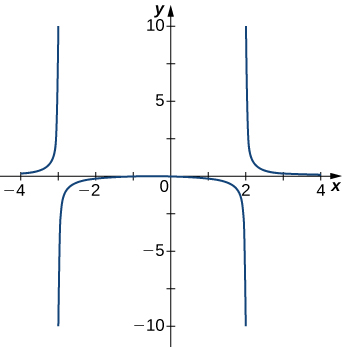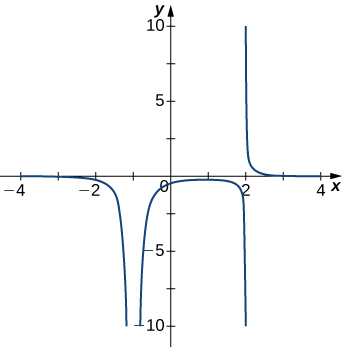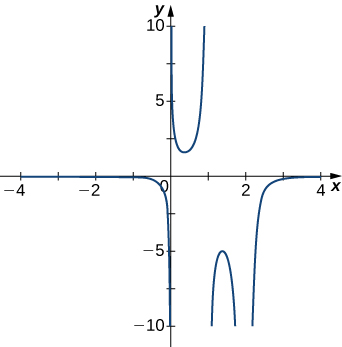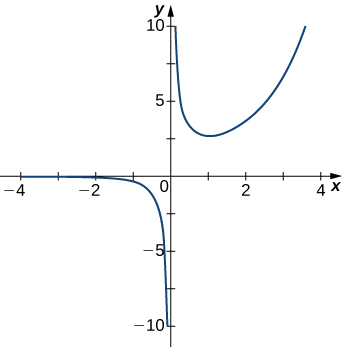For the following exercises, examine the graphs. Identify where the vertical asymptotes are located.
251)

- Answer:
- x=1
252)

253)

- Answer:
- x=−1,x=2
254)

255)

- Answer:
- x=0
For the following functions f(x), determine whether there is an asymptote at x=a. Justify your answer without graphing on a calculator.
256) f(x)=x+1x2+5x+4,a=−1
257) f(x)=xx−2,a=2
- Answer:
- Yes, there is a vertical asymptote
258) f(x)=(x+2)3/2,a=−2
259) f(x)=(x−1)−1/3,a=1
- Answer:
- Yes, there is vertical asymptote
260) f(x)=1+x−2/5,a=1
For the following exercises, evaluate the limit.
261) limx→∞13x+6
- Answer:
- 0
262) limx→∞2x−54x
263) limx→∞x2−2x+5x+2
- Answer:
- ∞
264) limx→−∞3x3−2xx2+2x+8
265) limx→−∞x4−4x3+12−2x2−7x4
- Answer:
- −17
266) limx→∞3x√x2+1
267) limx→−∞√4x2−1x+2
- Answer:
- −2
268) limx→∞4x√x2−1
269) limx→−∞4x√x2−1
- Answer:
- −4
270) limx→∞2√xx−√x+1
For the following exercises, find the horizontal and vertical asymptotes.
271) f(x)=x−9x
- Answer:
- Horizontal: none, vertical: x=0
272) f(x)=11−x2
273) f(x)=x34−x2
- Answer:
- Horizontal: none, vertical: x=±2
274) f(x)=x2+3x2+1
275) f(x)=sin(x)sin(2x)
- Answer:
- Horizontal: none, vertical: none
276) f(x)=cosx+cos(3x)+cos(5x)
277) f(x)=xsin(x)x2−1
- Answer:
- Horizontal: y=0, vertical: x=±1
278) f(x)=xsin(x)
279) f(x)=1x3+x2
- Answer:
- Horizontal: y=0, vertical: x=0 and x=−1
280) f(x)=1x−1−2x
281) f(x)=x3+1x3−1
- Answer:
- Horizontal: y=1, vertical: x=1
282) f(x)=sinx+cosxsinx−cosx
283) f(x)=x−sinx
- Answer:
- Horizontal: none, vertical: none
284) f(x)=1x−√x
For the following exercises, construct a function f(x) that has the given asymptotes.
285) x=1 and y=2
- Answer:
- Answers will vary, for example: y=2xx−1
286) x=1 and y=0
287) y=4,x=−1
- Answer:
- Answers will vary, for example: y=4xx+1
288) x=0
CHAPTER REVIEW EXERCISES
CR 1) limx→∞3x√x2+1√x4−1
- Answer:
- 3
CR 2) limx→∞cos(1x)
CR 3) \displaystyle \lim_{x→1}\frac{x−1}{sin(πx)}
- Answer:
- −\frac{1}{π}
CR 4) \displaystyle \lim_{x→∞}(3x)^{1/x}